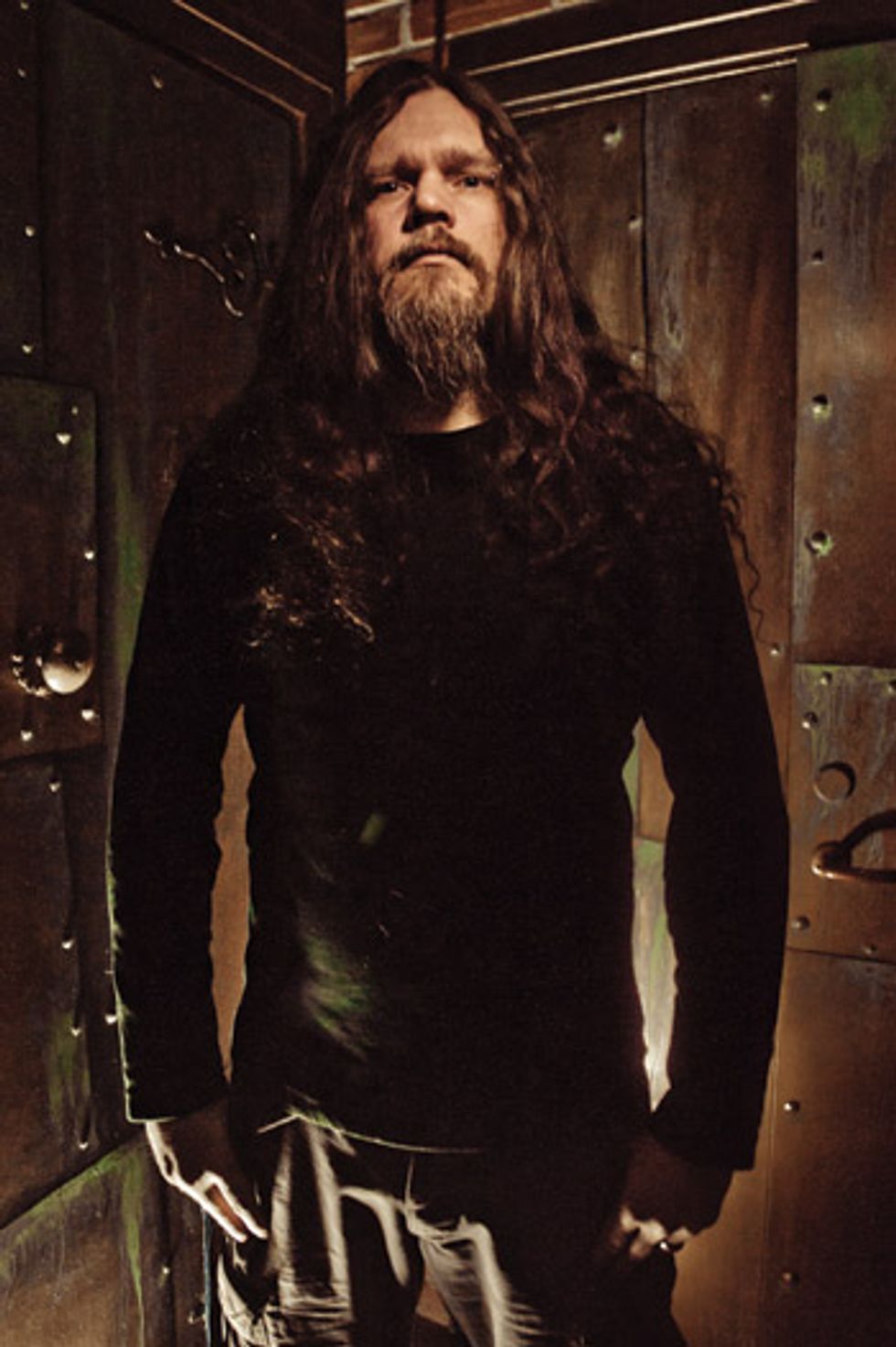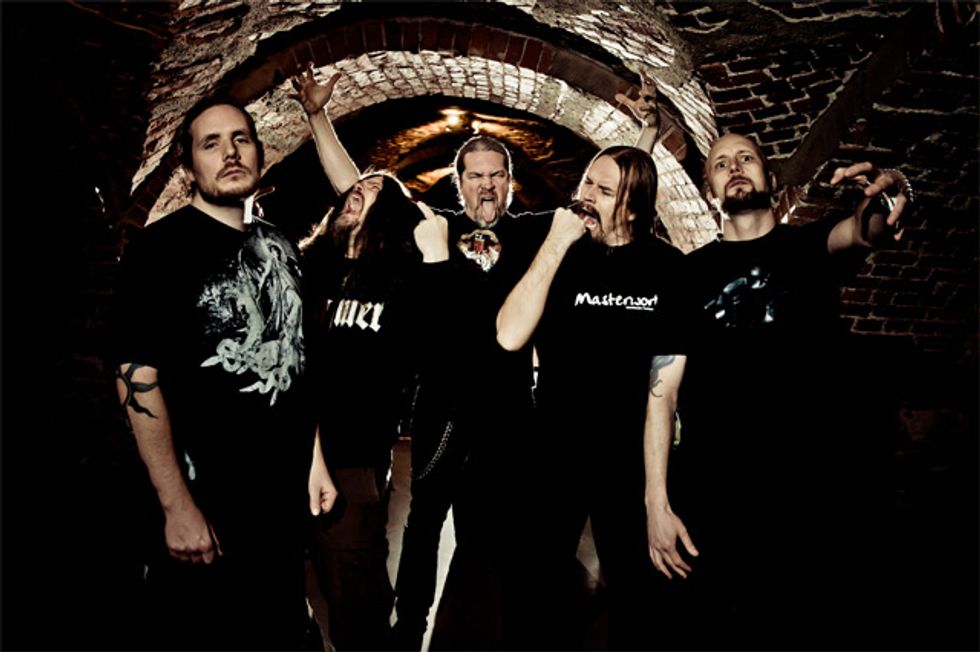Although "Koloss" might be more accessible than past works, guitarist Mårten Hagström says it contains some of their most complex compositions to date

After all, Meshuggah completely revolutionized the extreme metal genre with their brand of ultra-complex, ultra-technical, 8-string detuned doom, executed with super-human levels of precision. So profound is Meshuggah’s impact on modern music that their music has been examined by the haughty academic journal, Music Theory Spectrum, in an article entitled “Re-casting Metal: Rhythm and Meter in the Music of Meshuggah,” and is the focus of courses taught at the world-renowned Berklee College of Music. But even more relevant than its place in the confines of highbrow academia, Meshuggah’s influence can be heard in the music of current leading metal bands like Animals as Leaders and Periphery, among countless others, who have taken inspiration from the band’s mind-boggling metrical mischief and lead guitarist Fredrik Thordendal’s Allan Holdsworth-influenced lead guitar stylings. Meshuggah’s influence on today’s extreme metal scene is so pervasive that there’s even a Facebook page called “Meshuggah did it first, Meshuggah does it best. Stop trying.” Regardless of whether or not any band should cease taking influence from these brutal braniacs, there’s no denying that since Meshuggah’s inception in 1987 (Hagström joined the band in 1992), the bar has been raised super high, and the level of technical complexity in the genre has increased exponentially, undoubtedly as a direct result of Meshuggah’s innovations.
We recently caught up with Hagström to get the inside scoop on the making of Koloss, to get a firsthand account of Meshuggah’s mathematical approach (a term that Hagström despises), and to get the low-down on the band’s extended-scale signature Ibanez guitars.
It seems you guys put out a new studio album every three or four years. Given that your last album, obZenI was released in 2008, the timing of Koloss makes sense. What gave you the impetus to finally get back into the studio?
When we started to feel that the major part of the obZen touring cycle was coming to an end, it was just about time to get our asses into album mode. There is always a certain point where we feel the urge to see where we're going next. That’s when it all starts.
What was the writing process for Koloss?
It started the way it always does: messing around with a couple of ideas here and there. We normally write stuff on the computer by ourselves and then, kind of, show it to the other guys as a “demo.” After a while, things start rolling and all of a sudden we find ourselves in a state of pure chaos where we thrash out ideas, re-arrange and modify. The general concept or approach hasn't really changed that much. The tools have, but not the approach. We usually run through the stages—writing, arranging, recording, and mixing—separately. It’s obviously been different in many ways from album to album but the “modus operandi” has been similar if we are talking about writing. The ideas, however, have hopefully evolved a little through the years.
So was it business as usual for the Koloss studio sessions?
This time we did it a little bit different. We started writing but then took a break to go on a summer festival run through Europe, and since we almost never write on the road, we came back and sort of picked up where we left off but instead of finishing the writing process before recording, we actually ended up doing it all simultaneously.
Did this prove to be advantageous?
I think doing that was a great thing for the end result. When we started to lay down the drums for “Swarm,” we still had half the album left to write. It gave us a new kind of perspective, going back-and-forth between the two.
Earlier you said that your ideas have evolved over the years. Can you tell us more about what advances you’ve made to your signature sound?
With every release, we've always tried to tweak and experiment with our musical expression. I guess it’s been kind of this ungodly symbiosis between a bunch of stubborn, fucked-up individuals from the northern part of Sweden sharing the same view on what’s cool about playing in a band—weird and eerie is the goal. We are all rooted in the composing of music rather than being instrumentalists to some degree. So I guess trying to craft a voice of our own has been the goal. Not to be mistaken for trying to be as complex or technical as possible, as many seem to think.
That’s interesting because it seems that for many of the countless bands that have been obviously influenced by you guys, the goal is to make things as complex as possible. They’re approaching the music primarily from a technical point of view.
That in and of itself is utterly pointless, in my opinion. Our approach has always been about the general expression—and we like weird stuff. The technical aspect is just a by-product.
Speaking about the many Meshuggah-inflenced bands, are you flattered or irritated when you hear them? I guess flattered would be more appropriate. I mean, I'm really out of touch with what bands are considered to have done that. But if people say that we have inspired them in any way, I think it’s awesome. It must mean that we probably did a few things right along the way.
Yeah, some of these bands are quite amazing. Have you also taken inspiration from a band that may have started out as a Meshuggah disciple?
Not that I know of. Like I said, I'm not very in touch with the scene right now. Mostly because the band has been eating so much focus. And I really wouldn't know who you consider a Meshuggah disciple, so I guess the answer really is: I don't know.

Can you quickly summarize your mathematical approach for our readers?
There is no mathematical approach. I dislike that term. I hate speaking about it in these terms, but it’s a valid question. It’s just that analyzing something that we have been doing as a natural process doesn’t feel right to me. It’s getting the focus away from the fact that we are trying to deal with an emotional expression that also happens to fuck with your mind. That’s it.
And to really mess things up for you and get even more vague, and this applies especially to Koloss, there is no one formula that everything we do follows. The logic that might be underlying most of our stuff is sometimes thrown out of the window completely (laughs). The new album is full of that type of illusion.
But there has to be some kind of analytical process to get riffs to ultimately align in time, no?
I’ll put it this way: When I get an idea, it’s never a thing where I sit and count or figure out the theoretical aspect first. When the first idea/ideas are crafted and arranged with other ideas into a song, that’s the first time that the theoretical part comes into play. But initially, it’s just going with whatever your imagination feeds you. From a theoretical aspect, we could go into odd groupings and for memorizing certain things, it is maybe a useful term. But it really takes more away from the music than it clarifies.
To put it in a general term—which in my mind, makes a lot more sense—it’s like taking a rhythmical figure (or any number of rhythmical figures) and “super-imposing” them over a 4/4 frame. It almost resembles a puzzle. The rhythmical figures in our music don’t “land” and repeat themselves with every bar.
What’s cool is that even though all of these superimposed rhythms are really complex, it’s all typically done over 4/4. I guess the trick is that unlike most 4/4-based music, where the phrases are clearly delineated, your phrases start over in different places in the measures.
Where a standard blues riff finds its way back to “one” and re-starts when the next bar starts, our riffs rarely do. If they ever even out—and a lot of times they don’t, they might find their way back after 16 measures, for instance. It really isn't all that special from a theoretical standpoint. This concept is present in so much music and so many genres.
But you’ve taken this simple concept to heights previously never reached.
We tend to work with really odd rhythmical patterns, however, and mess around a lot with how the notes in the riff might point to the riff working toward a natural conclusion that the rhythm pattern doesn't really support.
For most guitarists, playing a riff while hearing the drums simultaneously imply a different meter can be extremely hard to do without some serious practicing. How do you individually practice parts that might feel rhythmically uncomfortable at first, and also require precision—with a metronome, sequence, or drum machine?
For me personally, it’s just sitting with the guitar tapping the beat with my foot. Sometimes it might require a metronome, but that’s rare—even though it’s a great tool for getting the “sense” of what your problem is.
Everyone talks about your band’s rhythmic approach but what about your harmonic approach. Where does that come from?
I guess it’s very natural considering the topic here, but we move between using tritones and minor and diminished scales. I'd say that we stay away from major keys and then pretty much everything else is used. Dick Lövgren [bassist] who is very well versed in musical theory—which I am not—always points out that I tend to use a lot of counterpoint when I’m composing as well.
Tell us about your new signature guitar.
Our signature M8Ms are made by Ibanez. We just got them a while ago and they are modeled after the 8-string that we built with Ibanez. We didn't expect them to be quite as good as our originals, but man, they exceeded our expectations. They are actually a little bit better.
The M8M has an ultra-long 29.4" scale length. Do you have to do anything to accommodate this extended range?
Yeah, we have a custom string set made for us by Dunlop to accommodate for the extended scale of our guitars—.009, .011, .016, .026, .036, .046, .052, and .070. We also tune down a half-step from standard tuning.
Mårten Hagström Gear
Guitars
Signature Ibanez M8Ms
Amps
Fractal Audio Axe-Fx (no cabinets)
Strings
Dunlop .009, .011, .016, .026, .036, .046, .052, and .070
Picks
Dunlop
YouTube It
To see Meshuggah obliterate their audiences, check out the following clips.
Meshuggah electrifies a Tokyo Audience with a rendition of “Electric Red.”
Meshuggah performs their hit “Bleed” live in New York in this clip from their Alive DVD. Check out the haunting, dissonant clean-toned breakdown at 4:14 followed by a killer solo from Fredrik Thordendal starting at 4:48.
A look at Meshuggah at its most intense. This clip, from the 2005 Download Festival at Donington Park, England, features some great “WTF” guitar moments from 4:01–4:19, among its many highlights. As an added bonus, watch security remove a bandana-wearing fan at 2:29.


